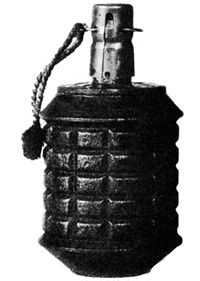Type 97 grenade
| Type 97 Hand Grenade | |
|---|---|
|
A Japanese Type 97 grenade, with the safety fork still in place. | |
| Type | Hand grenade |
| Place of origin |
|
| Service history | |
| In service | 1937-1945 |
| Used by |
|
| Wars |
Second Sino-Japanese War Soviet-Japanese Border Wars World War II |
| Production history | |
| Designed | 1936 |
| Specifications | |
| Weight | 0.45 kg (16 oz) |
| Length | (3.78 in) |
|
| |
| Filling | TNT |
| Filling weight | 2.2 ounces (65 grams) |
Detonation mechanism | Pyrotechnic delay 4 to 5 seconds |
The Type 97 Hand Grenade (九七式手榴弾 Kyūnana-shiki Teryūdan) was the standard fragmentation hand grenade of the Imperial Japanese Army and Imperial Japanese Navy SNLF during the Second Sino-Japanese War and World War II.[1]
History and development
The Type 97 was developed from the earlier Type 91 Grenade which could also be used as a fragmentation hand grenade, but was predominately used as munitions for the Type 10, and Type 89 grenade launchers. For this reason, it had less explosive power and a relatively longer delay time than a dedicated manual hand grenade. To address these issues, the Army Technical Bureau developed a new design in 1937.
Design
The Type 97 had the same principles as most of fragmentation grenades of the period: a grooved 'pineapple-shaped' segmented body which dispersed sharp pieces of shrapnel when it exploded. Operation was accomplished by first screwing down the firing pin, so that it protruded from the base of the striker. Then the safety pin was removed by pulling the cord to which it was attached; the protective cap which covered the striker was removed. A sharp blow against a hard surface, such as a rock or combat helmet would overcome a creep spring and crush a thin brass cap, allowing the pin to hit the primer and initiate the delay sequence before throwing at the target.[2] However, in comparison with Allied hand grenades of the period, the explosive force of the Type 97 was weaker, and the due to lack of an automatic ignition mechanism, the grenade in practice was found to be unreliable and even dangerous to use because of its inaccurate fuse.[3]
Physically, the Type 97 was almost indistinguishable from the Type 91, except that it had no attachment on the base for a propellant canister. Paper labels with ink-stamped fill dates warned of the shorter 4-5 second delay.[4]
Combat record
The Type 97 hand grenade was issued as standard equipment to Japanese infantrymen in the Second Sino-Japanese War and throughout the various campaigns of World War II.[5]
See also
References
- US Department of War (1994). Handbook on Japanese Military Forces, TM-E 30-480 (1945) (reprint ed.). Louisiana State University Press. ISBN 0-8071-2013-8.
- Rottman, Gordon L. (2005). Japanese Infantryman 1937-1945. Osprey Publishing. ISBN 1-84176-818-9.
- Departments of the Army and the Air Force (1953). Japanese Explosive Ordnance, TM 9-1985-4. ASIN B000H7NCDS.
External links
- Image of a Type 97 grenade
- Details of internal construction
- Taki’s Imperial Japanese Army page
- US Technical Manual E 30-480
Notes
| ||||||||||||||||||||||||||||||||||||||||||||||||||||||||||||||||||||||||
The following U.S. intelligence report on Japanese grenades was originally published in Tactical and Technical Trends, No. 5, August 13, 1942. [DISCLAIMER: The following text is taken from the U.S. War Department publication Tactical and Technical Trends. As with all wartime intelligence information, data may be incomplete or inaccurate. No attempt has been made to update or correct the text. Any views or opinions expressed do not necessarily represent those of the website.]
JAPANESE GRENADES Grenades are particularly useful to the close-in tactics of jungle fighting and the Japanese have used them extensively in their operations in the southwest Pacific and Burma areas, especially with grenade throwers. The following information on Japanese grenades is therefore of interest.
(a) Hand grenade. A grenade examined in Burma is described as follows (see accompanying sketch): The grenade is cylindrical in shape and has a grooved cast-iron body. A plug (10) is screwed into the top of the body through which extends a brass igniter tube (4). The striker (5) with holder (3) creep spring (6) and percussion cap (7) are located in the upper part of the tube while the lower portion contains the fuse and detonator (14). The tube is closed at the top by a light brass cover (1) crimped near the middle to fit into a groove in the tube and held in position by a safety pin (2). The safety pin supports the striker holder and prevents the downward movement of the striker on to the percussion cap. The fuse and detonator are separated by a perforated steel disk (15). The filling (16) is composed of T.N.T.
The dimensions and weights are: Maximum diameter 1.97 in. Overall length 3.78 in. Weight 16.5 oz. Weight of filling 2 oz. [Japanese Hand Grenade] Japanese Hand Grenade
